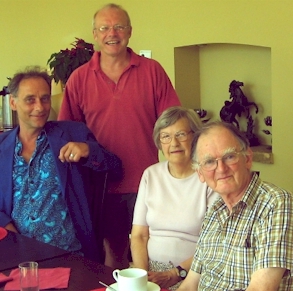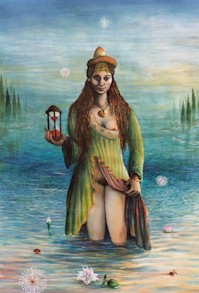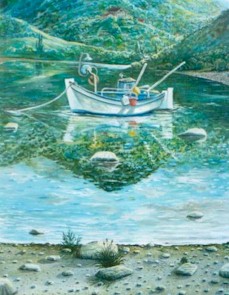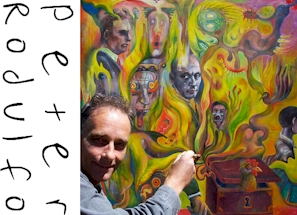 Photo shows Pete Rodulfo, Pete Talbot, Glenys Maulden & John Maulden at the Exhibition Opening.
Photo shows Pete Rodulfo, Pete Talbot, Glenys Maulden & John Maulden at the Exhibition Opening.
You may see examples of Peter’s work at:
His cousin’s website – Raimundo Rodulfo; and
Peter’s own website – www.peterrodulfo.com
Of the present, Peter says: “I am an artist , which I guess it is no surprise. I went to art school after leaving Framlingham, and have carried on painting ever since – exhibiting my work in largely in Europe , USA, South America, and more occasionally these days in UK. At the moment, I am preoccupied in preparing for the “Retrospective Exhibition”, and much to my surprise have even managed to find some things that I did whilst at Fram.
I have one daughter, who ,as she is now 24 ,makes me feel my age; otherwise I could hardly believe so many years have gone by since schooldays!
Over the years I have run into a few old Framlinghamians. One such is Richard Basset G72-76, who I bumped into a few years ago, as he lives just a few hundred yards away! We see quite a lot of each other now. Another OF that I keep in contact with is Nick Marsden G72-76, who has just had his first novel published by Penguin in New Zealand.
Of his own art, Peter says: “My father was the son of a Trinidadian cocoa planter and my mother the daughter of a Danish night club owner. My family is of diverse nationalities.
I was born 1958 in the USA. My early years were spent in India and Australia. My father, Monty Rodulfo, was involed in intelligence work and travelled a great deal. However, he also painted throughout his life, and it was he that gave me my first painting lessons.
Other than my fathers art, the first art that I recall seeing were the ancient wall paintings of the Ajanta caves in India. They made a big impression on me. For many years Asian art held as much fascination for me as European art.
The first European 20th century artist that I remember liking was Paul Klee.
When I reached Norwich school of art in 1975 my tastes had become eclectic in the extreme, and cursed with such uninspired dullards of tutors such as Jon Wonnacott, I quickly became disenchanted with an art establishment that I felt utterly out of step with.
Art that did influence me at this time was by Dubuffet , Outsider Artists, Tantric Art, Paul Klee, the Hundertwasser, Schwitters, Max Ernst, and Samuel Palmer. After looking at Kurt Scwitters I came to making collage, and progressed from there to sculpture.
I have no fixed intentions in my art. It is a journey without a goal. If I have an intention it is to have no intentions.
I try to be as free as possible from personal and cultural censorship.
There can be no manifesto for me.
It is sometimes supposed that there are stories behind my paintings, but there are none, I concentrate on the formal structure of the piece and the images come of their own accord; they well up from what I presume to be a source within myself, and when they reach the surface they mingle with my more prosaic experiences and memories until they congeal into a fixed image.
I have many different ways of working, but the method I have returned to most frequently over the years owes alot to Max Ernst and Leonardo Da Vinci. I start with nothing, no idea at all and proceed to chaos. I cover the canvas with paint which I then manipulate and push around until the picture is fertilised and images are born. I have to become immersed, almost unconscious; the nearest analogies would be sex and prayer. Once images start appearing the picture takes on many possible lives, and images are changed and obliterated until the picture has evolved to the point where nothing more can be changed.
 I had my first exhibition in 1976 whilst still at art scool. Immediately upon leaving artschool I was taken up by the Margaret Fisher Gallery in London. Margaret was from a renowned Viennese family of art dealers. Margaret was a particularly close friend and supporter of Oscar Kokoschka and many other of the great 20th century artists. And so it a was a great honour and encouragement and help to me that
I had my first exhibition in 1976 whilst still at art scool. Immediately upon leaving artschool I was taken up by the Margaret Fisher Gallery in London. Margaret was from a renowned Viennese family of art dealers. Margaret was a particularly close friend and supporter of Oscar Kokoschka and many other of the great 20th century artists. And so it a was a great honour and encouragement and help to me that
she took me under her wing during those difficult early years.
Another collector and supporter from those days was Gustav Delbanco of “Delbanco Browse and Derby Gallery” in London`s Cork street. Gustav was immensely knowledgeable on all aspects of art and like me his tastes were eclectic . It was he who first showed Paul Klee to England There again, it was a great encouagement for me that Gustav appreciated my work too.
Through most of the 1980’s I continued to show at Margaret Fisher’s gallery and didn’t concern myself much with seeking other venues. Nevertheless as I attracted good reviews from the critics opportunities came along and my work started to find an international audience.
Whilst my art started to nudge its way into the world I was living a reclusive life in a decrepit cottage at an obscure location in the tail of a hippy dream. Here I was surrounded by woods and they became very much part of my life; not least because I had to find firewood each day. I paid a minuscule rent and loved the trees, and so although I had intended to move to London I never did. Before long I was growing vegetables and keeping chickens and soon a wife and a daughter came along too.
I had moved into the countryside during my last year at art school. Whilst I was a student I had been disconcerted to observe that very few students continued to produce art for very long after leaving art school. Through fear of the same thing happening to me I set myself a rigid work routine. It was pretty easy to keep to though, because soon I was working obsessively from dawn to dark and beyond.
In 1987 I moved back into the city. A little while later I started to work in the co-operatively run ‘Warehouse Artist Studios’ in Norwich; where I continued to paint for several years, until the need for solitude took me over again.
 After leaving art school, I had felt that I had artistic indigestion so wanted to completely re invent my art even though a leopard never changes its spots. The first step I took was to abandon figurative representation. I never intended my art to remain abstract, but I wanted to rebuild it from the basics. At first I limited myself to using only multiple squares or rectangles of colour; influenced I think by Paul Klee’s magic square pictures. Soon I started adding semi transparent glazes and diverse random paint effects, and the imagery started to surface again.
After leaving art school, I had felt that I had artistic indigestion so wanted to completely re invent my art even though a leopard never changes its spots. The first step I took was to abandon figurative representation. I never intended my art to remain abstract, but I wanted to rebuild it from the basics. At first I limited myself to using only multiple squares or rectangles of colour; influenced I think by Paul Klee’s magic square pictures. Soon I started adding semi transparent glazes and diverse random paint effects, and the imagery started to surface again.
In the 1970’s I had often worked with collages and photocopiers, and in the early eighties I revisited this aspect of my work. The collages grew more 3 dimensional and this led on to relief constructions. This process was speeded up by my meeting with the master puppeteer and artist Guy Richardson, who at this time was making fantastical constructions. The artist Bruce Lacey, who lived nearby, also played his part, periodically appearing on my doorstep with strange assortments of objects to incorporate into my constructions.
I had from the earliest days occasionally made sculptures, but I had little confidence in them, and usually destroyed them on completion. The relief constructions helped me gain the confidence to approach sculpture again.
At the beginning of the 1990’s my work began to appear in the international art fairs, and it was in this context that I first met the sculptor Stephen Vince. After one art fair I used the financial proceeds to return to the far east. Stephen was sculpting in Thailand at the time, so we met up again in Bangkok. Stephen was working at a small bronze foundry in a quiet and watery village a few miles outside the city. Stephen suggested that I join him there and try some casting. The foundry used the lost wax method of casting, and as soon as I had a lump of wax in my hand I was enthralled. The foundry normally made Buddha’s and was run by an unlikely pair. One was an American, Larry Vallas, a volatile bullet of a man with bad toothache, which made him a bit crazy, but he managed to keep his cool with me, and loved what I made. I had now run out of money again, but Larry offered to cast for free as much as I could produce in exchange for some pieces for his own collection. Larry’s partner an astute chinese business man, named Luck, was not very happy with this arrangement. Luck was absolutely unfamiliar with Western art, and at first he thought we were dangerous lunatics; he would watch with nervous puzzlement as Stephen and I worked in a fever of activity. However, Luck was impressed with hard work in any form, and so he began to be won over. By the time the first bronzes were cast, Luck was as excited as ourselves. Luck decided that he also wanted some of my sculpture for himself and so for several months I continued to work with abandon producing 100 of my first bronzes. These I took on to Hong Kong, where a fortuitous meeting led them to being exhibited in Hong Kong museum.
On my return to England I went back to painting, which for a while became considerably lighter in feel, due to my experience of the orient. I continued to produce sculpture, but the cost of casting in the UK was prohibitive, so only a tiny portion of my output reached a permanent form. Most of what I produced ended up in the melting pot. However in 1995 I became artist in residence at the sculpture department at the Norwich School of Art. Once again I had access to casting facilities. At this time I also started to make cut and welded polychrome metal sculptures. I loved the speed of execution and sense of play that these methods allowed me. Again my early love of collage came into play.
Through the nineties I continued to exhibit in diverse towns and countries.
At this time I began the first of my collaborations with my cousin, the Venezuelan composer and guitarist Raimundo Rodulfo. Working on marriages of music and imagery, and so it was that in 2002 my art made its first foray in to Latin America, with an exhibition in Venezuela.
In 2003 I happened to exhibit in an international open show of imaginative and visionary art. The patron of this exhibition, was the Baron of Fulwood; in due course I came to paint his portrait, and we struck up a friendship.
The Baron of Fulwood has a foundation devoted to fostering cultural links between the UK, South Africa, and Brazil. I was offered a residency and exhibition in Brazil, and so very suddenly in 2004 I found myself on one of the Barons farms in Brazil. I was surrounded by monkeys and macaws, termite hills and toucans, cattle, strange fruit, vultures, palms and pockets of jungle. My studio was a wooden summer house on stilts in the middle of a lake. There were also visits and an exhibition in the nearest city, Goiania, the home town of Ana Marie Pacheco, who coincidentally had left there to become head of painting at Norwich School of Art. In Goiania I met with many artists, but found a particular rapport with the extraordinary Poteiro, the renowned ‘primitive’ artist.
 To this day the Baron of Fulwood continues in his patronage of my art and is currently promoting my art in the USA. At this moment I divide my time between painting, sculpture and etching, but in particular I am producing preparatory work for a large mural in Bylaugh Hall.
To this day the Baron of Fulwood continues in his patronage of my art and is currently promoting my art in the USA. At this moment I divide my time between painting, sculpture and etching, but in particular I am producing preparatory work for a large mural in Bylaugh Hall.

Comments
Join the conversation
Log in to add your comment
0 comments